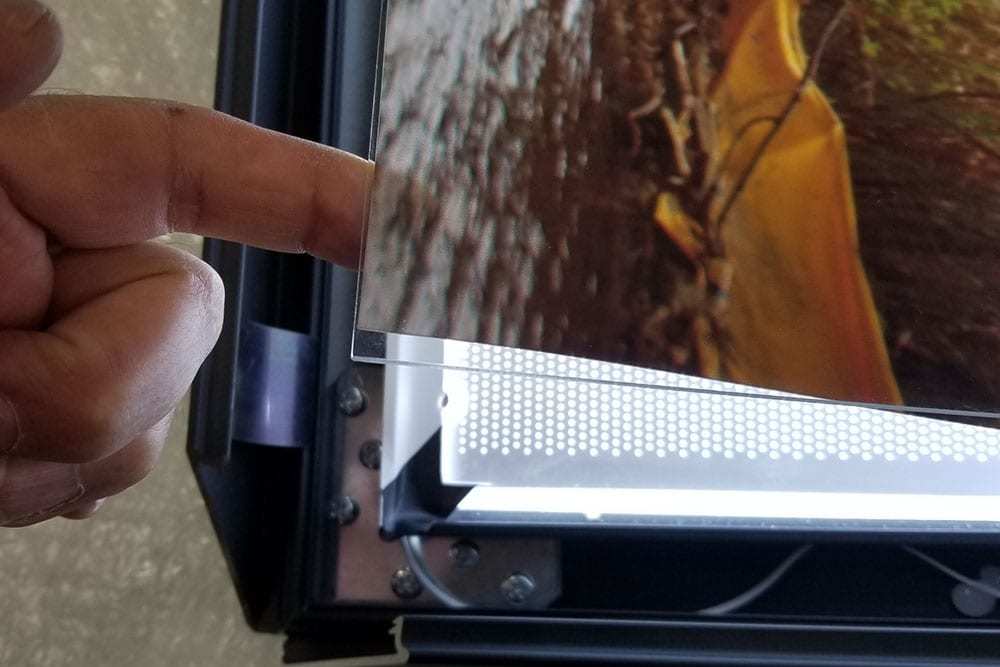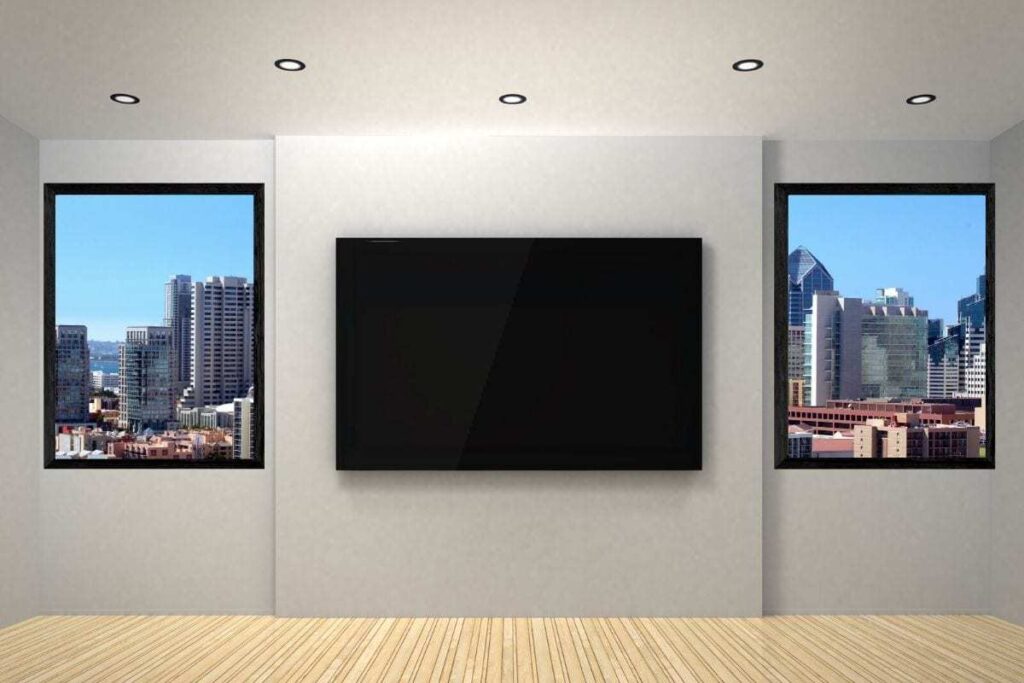Lightboxes can be used as a faux windows option in dark rooms without real windows. Finished basement spaces and home offices are fast becoming normal living and working places for many people in Canada and the US. Many of them are mostly dark and windowless. Hence, the need for fake windows.
If you are renting out your basement, they can be a great option for low-income groups such as students. Apartment prices are on the up in most cities, so basement apartments are getting more socially accepted. The only issue is that for the most part, they have no windows.
Faux windows for your basement are a simple solution. Moreover, installing a fake window in your basement using a light box design is the most effective way of lighting up the area.
How to Create Faux Basement Windows With Light Boxes?

A lightbox used as a faux window is an LED snap frame with or without a translucent poster. The LED snap frames are great options for advertising companies, signage companies, and more. At the same time, they are the best option for faux/fake windows.
Using a lightbox as a fake window for your basement offers a lot of benefits.
For starters, it provides the room with a realistic ambiance.
Additionally, if you intend to sell the space, a fake window can make the room look more inviting.
The best part about lighting up your basement with a light box is that it can be a simple DIY project. You can either buy a ready made one, with different options, or you can put together a faux window light box for your basement from scratch. It requires some technical expertise, though. If you want to get one that is ready to install, you just have to make sure that you buy a light box from a reliable online store and you are good to go.
Click here to learn more about the LED Faux Windows.
“Fake windows” options for a basement or home office
Typically, faux window options are used in cramped windowless spaces such as hallways and storage spaces. With advances in lighting tech, combining a lightbox with your fake windows is an amazing way to light up your basements or any other space in your home. Some interior designers have great ideas in this matter. Laurel Home, and beHOME give you lots of insights.
But first, let’s take a look at other options for lighting up your basement.
Using a lightbox to light up your basement by constructing a fake window is the most effective lighting option for the basement and other dark spaces. However, it doesn’t mean that there aren’t other ways to make your basement look brighter.
The trick to lighting up a room without windows is to create the image that there is a window somewhere in the room. This, combined with the right lighting equipment, paint and furniture can turn your basement into a haven of “light”.

Use mirrors to simulate a window
Hanging an oversized mirror somewhere in your basement can be a fake mirror option. You can mount the mirror opposite a sofa or a bed, using wooden blinds to create the illusion of a window.
A more cost-effective option is to hang different mirrors of varying lights all across your basement. You can place these mirrors in any arrangement that suits you. Afterward, drape white lights around them for a sparkle effect.
As highly reflective surfaces, these mirrors will bounce and reflect light all around your room for an unbeatable dazzling effect. Big mirrors would also give an illusion that the room is spacious. If you want to get highly creative, you can choose to vary the colors of these lights.
Use drapery to create window illusions
Also, you can hang drapery on a rod and place it over a large mirror. This will make it look like there are windows in the space. One great place to use this effect is behind the headboard in your room. Hanging beautiful floor-to-ceiling drapery behind your headboard can make it look like there is a window that is always closed at present.
Install the right lighting
The right lighting can make your basement space airy and look more spacious than it really is. You can achieve this effect by using layered lighting in the basement. This layered lighting can be combined with the light from overhead fixtures such as chandeliers.
Recessed lights at dim corners and around artworks in your basement can light up the room significantly. You can also run strip lights across lower and upper cabinetry features in the room. This can be combined with diffused lighting installations to brighten up the surfaces in your room.
Keep the decor light and simple
Most people make a significant mistake with their basement design efforts. They go for over-the-top layered designs that can make space look darker than it really is. If you want to light up your basement, then going for different light colours and simple furniture can do the trick.
For instance, a good idea is to paint the walls white for a breezy, orderly appearance. This can be layered with bright fabrics and accessories to give the room a lot of texture without cluttering it.
When it comes to furniture fixings, the best course of action is to keep furniture lines streamlined and clean. Avoid embellishments that will make the room look crowded. Instead, choose furniture with slim legs to expose more of the floor and make your room more spacious.
The equipment you need
Below are the tools you will need for your fake windows project:
- LED Lightbox.
- Picture of scenery (It typically comes with the LED lightbox)
- Pieces of wood. Weathered wood is best.
- Tables saw
- Glue
- Pin nailer and nails. 1 ¼ inch nails are best.
- Plywood.
- Aerosol adhesive
- Extension cord. This may be optional if you have a near enough power outlet
- Horseshoe clips
- Cordless drill and a ½ inch drill bit
Learning how to light up your basement with faux basement windows using a lightbox is important. However, it is necessary that you always follow certain safety measures. Be sure to wear regulation safety glasses when working with nails, wood, and power tools. Safety gloves are also a necessity to protect your hands. Lastly, while working, use a fan to protect yourself from the fumes produced by aerosol adhesive glue.
A step-by-step guide
Follow these steps to a tee for effective results. However, remember that you can decide the specs of your fake windows based on your needs.
- Miter all the four pieces of weather wood to each other at a 45-degree angle. This should look like a square or a rectangle.
- Use glue to bond the four pieces of wood together. This structure will act as the frame of your fake windows.
- Using the pin nailer, install three 1 ¼ inch nails at every corner of the frame. After doing this, wait for about an hour for the bonding glue to dry.
- The permeable membrane of your fake window may be a scenic picture. You can also use a plain picture.
- Spray aerosol adhesive on the plywood and then place the scenery picture on it. Press and hold it down until it bonds completely to the plywood.
- Run a line of glue along the edges of your frame. Then, place the plywood with the picture facing down on the frame.
- Flush it in on the four sides using the pin nailer to secure the picture to the frame.
- Place a piece of weathered trim on the upper and outside edges of the frame.
- With the pin nailer, shoot three pins through each trim, securing it to the frame. Then, place the other two pieces of wood trim between the first two pieces and nail them to the edge of the frame.
This is where the lightbox comes in. Put the rope light behind the trim piece. Then, secure it to the lightbox using horseshoe clips. Afterward, run the cord behind the trim, drilling a hole in the bottom of the lightbox and running the cord out of the hole.
When this is done, place the lightbox wherever you want to install it on your basement walls. Then, drill two holes through the top corners of the picture. After this step, insert two toggle bolts through these holes, tightening them with a cordless gun. Plugin the lightbox cord and you will have a “window” with bright lights that look like the light is being let into your basement.
Tips You Should Know About Faux Basement Windows
When creating faux basement windows, there are a few considerations that have to be made. One important one is to consider the kind of lightbox you are buying.
First of all, make sure to only buy a lightbox from an online store with a history of delivering effective, functional products. This way, you will be sure to enjoy the use of your fake basement windows for a long time.
Secondly, if it is possible, you can integrate a remote dimmer system into your lightbox windows. This can seem like a pointless endeavor if you are looking to create only one fake window. However, if you are using multiple lightboxes, controlling the power in different lightboxes can become a bothersome task.
To that end, we advise our customers to integrate a dimmer system that is remotely controlled into their lightboxes. This way, you will not only be able to turn on all lightboxes simultaneously but you will also be able to control the brightness.
Conclusion
Using a lightbox to create a fake window illusion for your basement is a good idea. The best part is that it is an affordable project that you can handle yourself. With the short DIY steps outlined above, you can build a fake window for your basement in the afternoon, or buy a good quality one.
The key to lighting up your basement windows with a fake window is the lightbox. It is essential that you buy a high-quality light box that you will enjoy for a long time to come. Don’t make your decisions based on the pricing, instead buy a product whose use you will enjoy for a long time.
Are you looking to buy a lightbox to construct faux basement windows? Look through our online lightbox store today. Here at Prime Light Boxes, we offer different specifications and designs of lightboxes at competitive prices for customers in the US and Canada. Check our online store today!

